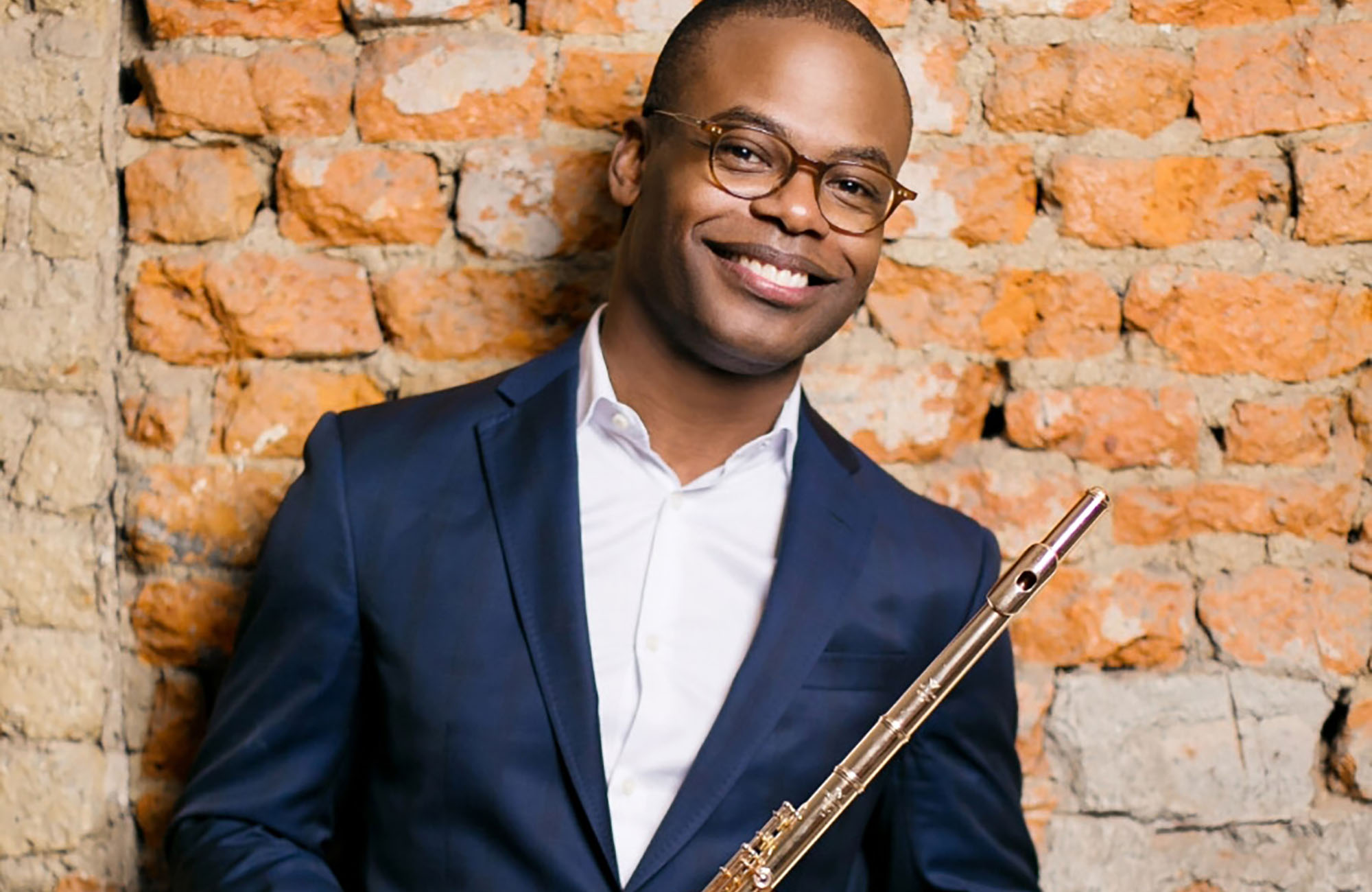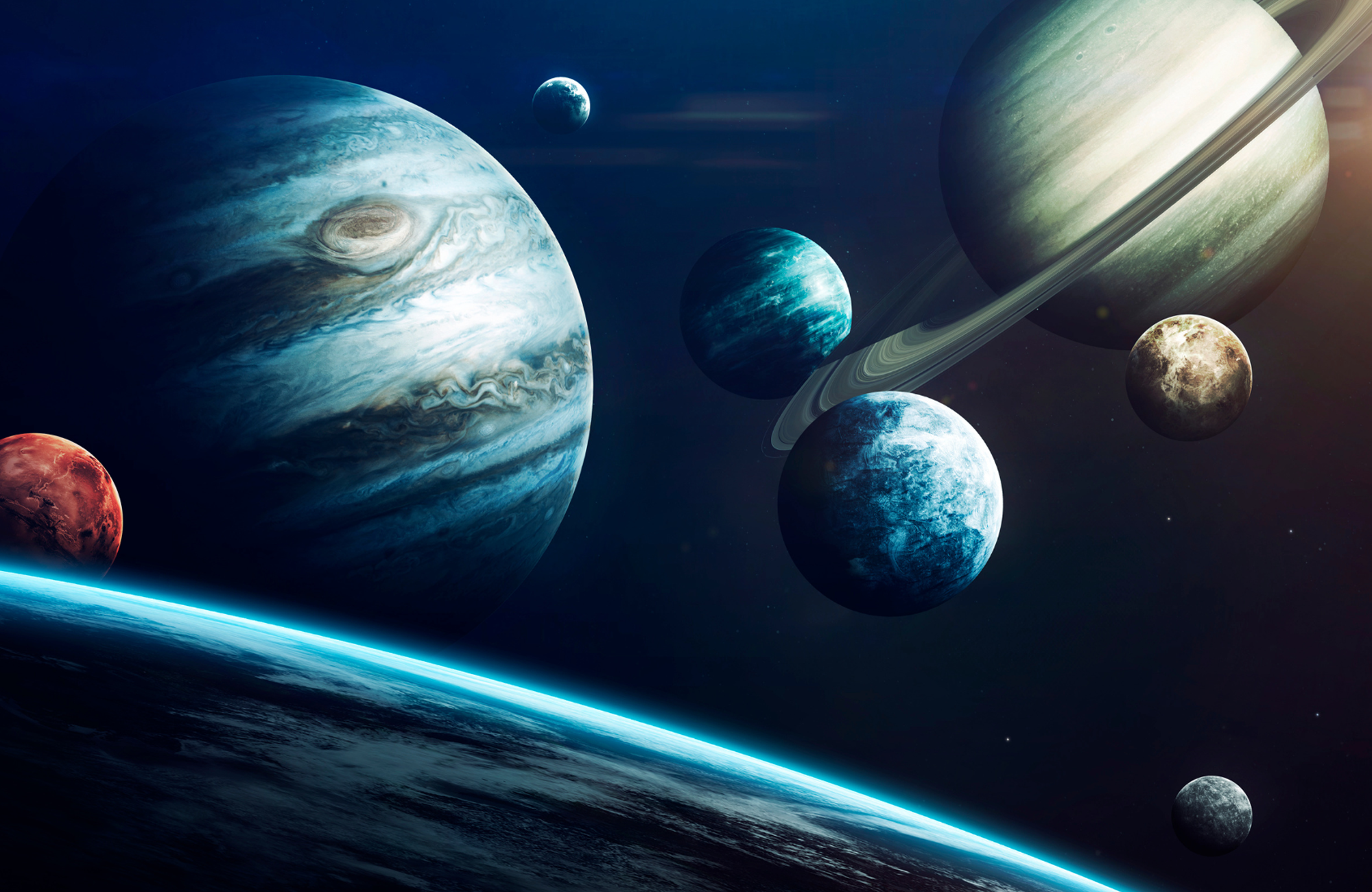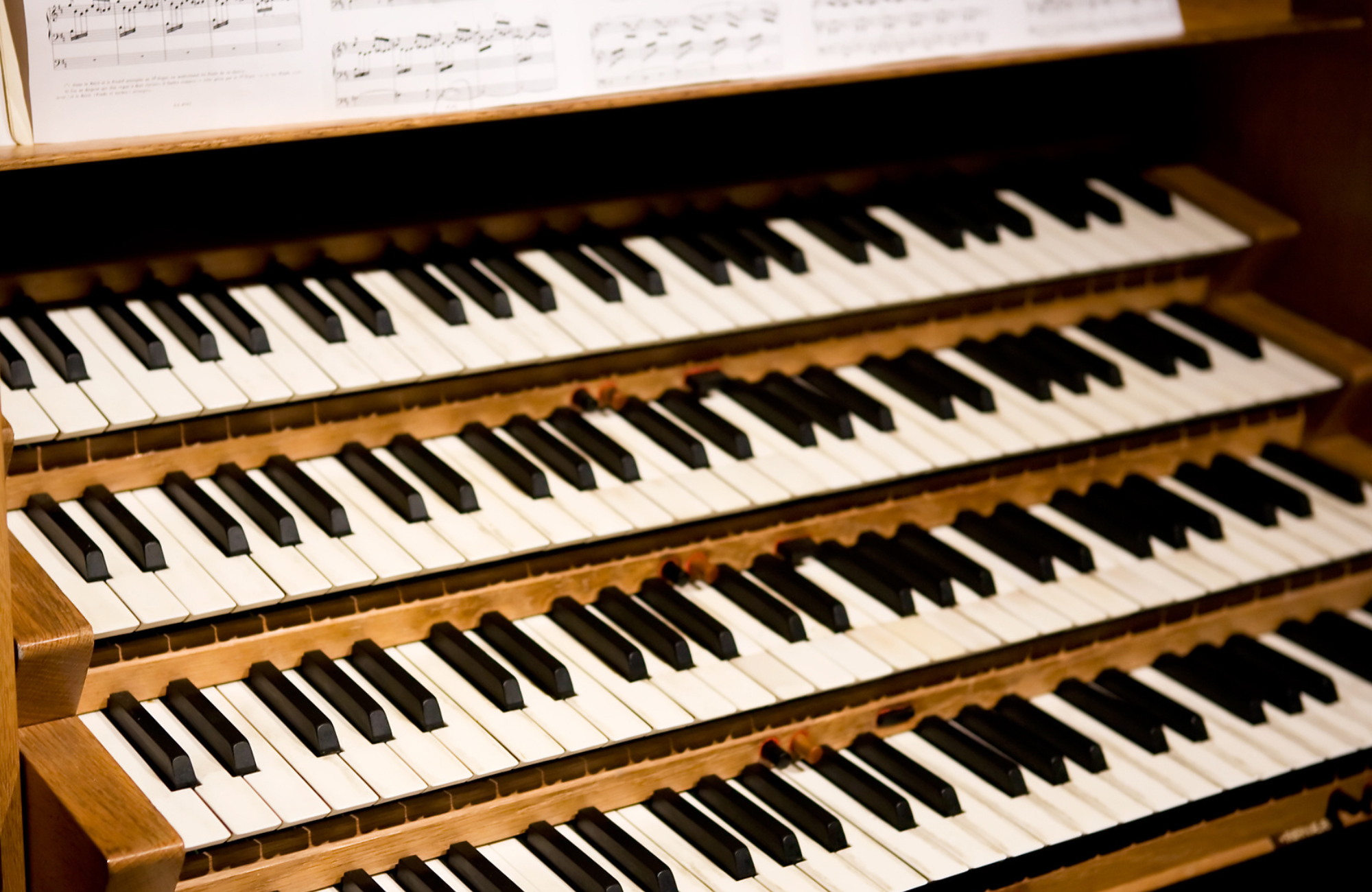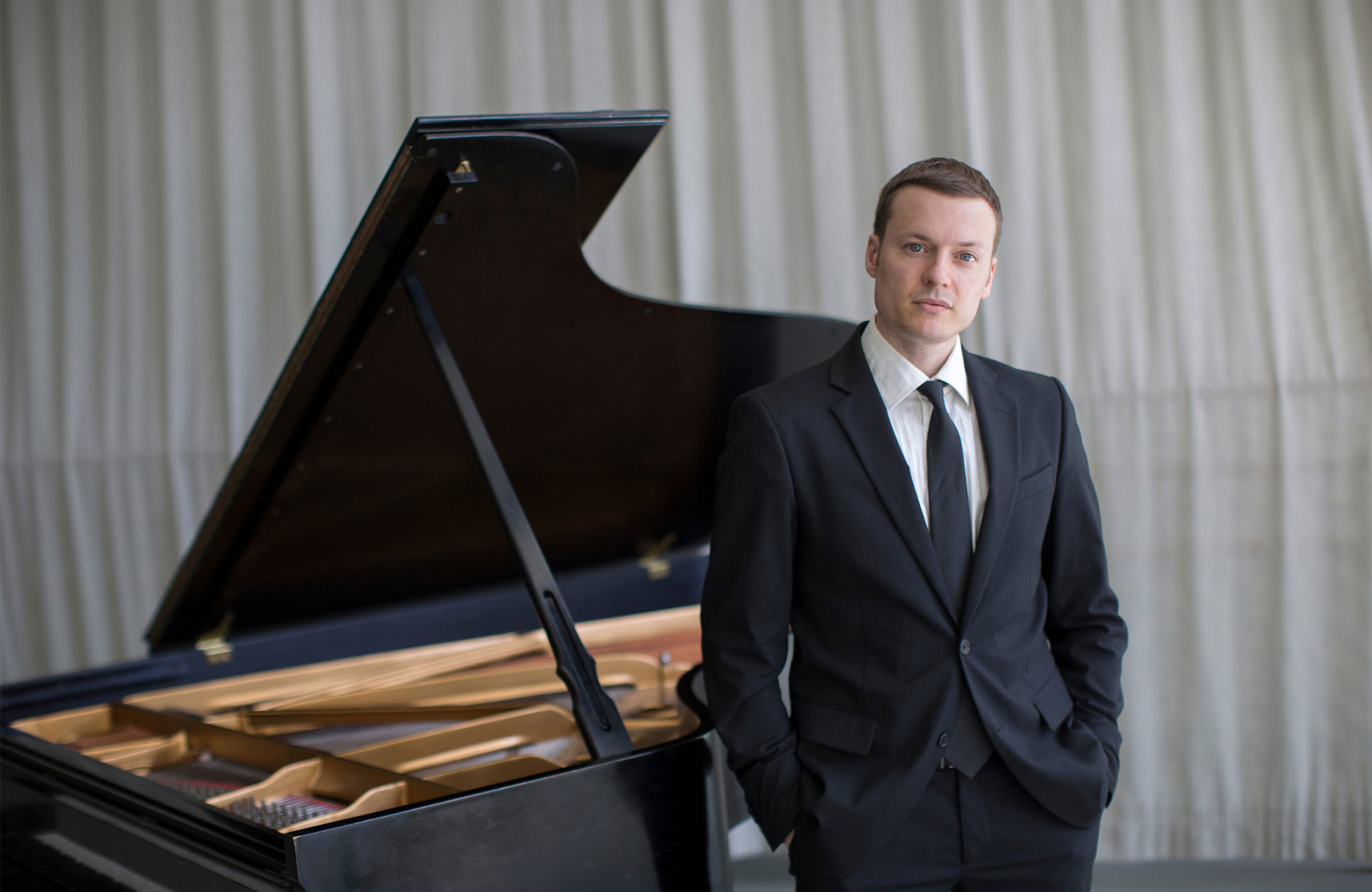The Syracuse University Oratorio Society Treble Chorus joins Symphoria for Holst’s influential, astrology-inspired orchestral suite, The Planets. Film footage of the planets will be projected on the big screen above the stage while the orchestra performs for an immersive, multi-sensory experience. Before intermission, principal flutist of the Seattle Symphony and incredible soloist Demarre McGill performs a staple of the Romantic flute repertoire, François Borne’s Carmen Fantasy.
PROGRAM
DEBUSSY: Nocturnes ![]()
BORNE: Carmen Fantasy ![]()
HOLST: The Planets ![]()
Note: The performance will feature real images of the planets taken by spacecraft, provided by the Spacecraft Planetary Image Facility (SPIF) at the Cornell Center for Astrophysics and Planetary Science.
Thanks to our sponsors for this performance!

Peter & Nancy Rabinowitz
Thanks to our media sponsor

PROGRAM NOTES
“Truth without authenticity”: that’s how Spanish composer Manuel de Falla praised “Soirée dans Grenade,” a piano piece by his French contemporary, Claude Debussy (1862–1918). At the time, Falla was writing about the “visionary genius” that gave Debussy—who in fact spent only a few hours in Spain in his entire life—the ability to summon up the spirit of Andalusia without falling back on the kind of folk-music cliches that circulated widely at the time. But his remark applies to Debussy’s music more profoundly and more generally. Debussy was, for the most part, a descriptive ...
“Truth without authenticity”: that’s how Spanish composer Manuel de Falla praised “Soirée dans Grenade,” a piano piece by his French contemporary, Claude Debussy (1862–1918). At the time, Falla was writing about the “visionary genius” that gave Debussy—who in fact spent only a few hours in Spain in his entire life—the ability to summon up the spirit of Andalusia without falling back on the kind of folk-music cliches that circulated widely at the time. But his remark applies to Debussy’s music more profoundly and more generally. Debussy was, for the most part, a descriptive composer; but even his most picturesque music differs profoundly from that of previous descriptive composers. It doesn’t aim to convey the character of the external world itself (he despised the nature-painting of Beethoven’s Pastorale Symphony); rather, it reflects what he called his “inner landscape”—the impressions of the world as recalled or imagined.
Thus, Debussy (in rather cryptic prose) described tonight’s offering, his Three Nocturnes (1897–99), as follows [my translation]:
“Nuages” (Clouds): This is the immutable aspect of the sky and the slow, melancholy march of the clouds, ending up in a gray agony gently tinted with white.
“Fêtes” (Festivals): This is movement, the dancing rhythm of the atmosphere with abrupt flashes of light. There is also the episode of a procession (a blazing and chimerical vision) that passes through the festive scene and becomes merged with it; but the background remains, fixedly and forever, the festival and its mixture of music and luminous dust joining in a universal rhythm.
“Sirènes” (Sirens)”: This is the sea with its infinite rhythms and then, amid the waves silvered by the moonlight, the mysterious song of the Sirens is heard, laughing and passing away.
Clearly, he’s evoking three scenes. But what kind of scenes? Clouds ending up in “gray agony”? The “dancing rhythm of the atmosphere”? A “chimerical vision”? These are not precise reflections of reality like those we heard in Vivaldi’s Four Seasons on our last Masterworks concert. Rather, they are dream images or memories of impressions created by that reality— filtered and enhanced, it would seem, by his experience with the painting, poetry, and music of his time.
Debussy writes some of the most gorgeous, most sensual music in the repertoire. But it’s never merely pretty. The sirens may have been beautiful, but their singing lured sailors to their deaths; and in retrospect (an appropriate way to think of Debussy’s music), the earlier two pieces have their darker implications, too. Nor, for that matter, is his music conventional. Although by now his style has become familiar, it was revolutionary in outlook at the time he composed it. In terms of color, his phrase about the clouds—“ending up in a gray agony gently tinted with white”—gives some sense of the subtlety of his use of the orchestra. But it’s his use of harmony that’s most striking. The standard Austro-German works of the 19th century were based on what was called “functional harmony.” This is a system in which each chord served a specific purpose, a system of dissonance and resolution that generated a sense of musical progression and closure. Especially in “Nuages,” Debussy often moved away functional harmony, ready to treat chords for their immediate, even static, sensuous appeal, rather than for their contribution to musical sequence. As conductor Larry Loh puts it, the music’s tonal centers “float around, making the listener feel uncertain about where the ground is.”
Debussy resisted the profligate orchestration favored by Wagner and Mahler, only using what was necessary. In this case, however, he felt that something extra was required, and he added a women’s chorus to “Sirènes.” Not surprisingly, though, he uses it in a special way, “as a color” in Larry’s terms, “bringing a human sound into the orchestra.” Because of the added difficulty of bringing in the singers, the first two Nocturnes are often performed without “Sirènes”; full performances, like tonight’s, are moderately rare. But when you hear the sounds that Debussy created, you’ll understand why he made the choice he did.
There’s also a women’s chorus in the other-worldly Neptune, which concludes The Planets (1914–1916) by Gustav Holst (1874–1934). The effect, though, is quite unlike that in Sirènes: icy and distant (Holst’s singers are off stage) rather than immediate and seductive. (Holst heightens the sense of distance by having the singers alone at the end, and having the door between them and the stage slowly close as they repeat the final measure “until the sound is lost in the distance.”) More generally, while The Planets is notable, too, for its ingenious use of orchestral colors, it’s radically different in sound from the Nocturnes. Or, perhaps I should say “radically different in sounds,” since each movement, like each movement of the Nocturnes, has a different flavor—there’s no overall Planets sound in the way that there’s an overall sound through the Brahms Third, which we also heard on the last Masterworks concert. Still, for the most part (“Neptune” being the most notable exception), the colors are splashier, grander, more spectacular than Debussy’s. Holst’s music is also more solidly grounded, especially in terms of its harmonic practice. No surprise, really, since as Larry points out, Holst is “dealing with more tangible matters.”
Tangible, but not exactly astronomical. Holst didn’t really intend the music to be a description of the solar system. True, each of the seven movements bears the name of a different planet (all of them except for Earth)—but each is also supplied with an epithet suggesting that its source lies in astrology and mythology. In any case, Holst’s sonic imagination is so vivid that the descriptions are unnecessary. Surely, you hardly need to be told that the opening movement represents “Mars, The Bringer of War” in order to feel the terrifying menace of the First World War (talk about “tangible matters”!) Nor do you need to know that the fourth movement represents “Jupiter, The Bringer of Jollity” in order to be uplifted (in fact, the noble big tune at its center has been adapted as a hymn). The Planets’ magnificent richness of timbre, its unrivalled variety (few other works cover such a range of moods), and its canny dramatic strokes (especially its eerie end) all make verbal explanation nearly irrelevant.
No wonder that since its first public performance roughly a century ago, it has been one of the most popular works in the repertoire, played not only by virtually every orchestra of sufficient size but also adapted for band and taken up, in whole or in part, by a variety of jazz and rock groups as well. It’s also been a great influence on film composers, most obviously John Williams, whose score for Star Wars draws much of its nourishment from Holst. And even if you’ve never heard the work before, it’s so immersive in its impact that, as soon as you start to listen, you’ll be caught up.
Between these two otherworldly works, we have a fantasy based on themes from the 19th century’s “earthiest” opera—Bizet’s Carmen. When it premiered in 1875, it provoked a scandal for a variety of reasons. It featured proletarian characters in all the leading, non-comic roles (no gods or nobles); it had an independent and sexually liberated protagonist who died on stage (the first time that had happened at the Opera-Comique, the house that premiered it); there was smoking on stage, too (by women, no less!): all of this ushered in a new, grittier kind of opera. (Debussy referred to Bizet’s “brothel kind of celebrity.”) But it quickly settled into the repertoire (too late for Bizet to see its success, alas), and it is now one of the most frequently performed operas in the world.
Its appeal comes partly from its double character. On the one hand, this is 19th-century opera at its most realistic. Carmen is based on Prosper Mérimée’s hard-boiled novel of the same name (I use the phrase “hard-boiled” advisedly, since it was a major inspiration for Raymond Chandler when he wrote his hard-boiled Philip Marlowe novels). And it shares not only the heightened drama of the original, but also its profound psychological insights into ethnic conflict, border-crossings, class, and of course gender. On the other hand, it may be the most hummable opera in the repertoire. Even if you think you don’t know it, you probably know many of its tunes, which have saturated our culture in movies, cartoons, ads, background music…. Bizet’s melodies have also been borrowed for variations and fantasies by composers and performers from Sarasate through Vladimir Horowitz and Franz Waxman (whose Carmen Fantasy originated in his score for the film Humoresque) on to Soviet post-modernist Rodion Shchedrin.
Among the most popular of these Carmen-based works is the Fantaisie brillante sur Carmen for flute and orchestra by French flutist François Borne (1840–1920), first published in 1880, just a few years after the opera’s premiere. Little is known about Borne, who would have been totally forgotten were it not for this dazzler (“all fun,” as Larry aptly describes it); but when you hear it, you’ll know why it has kept his name alive. Originally composed for flute and piano, it’s been arranged for flute and orchestra several times—tonight’s version was put together by James Galway. More music from Carmen, by the way, will return on our opera gala, Masterworks 6, on April 20, 2024.
Peter J. Rabinowitz
Have any comments or questions? Please write to me at prabinowitz@ExperienceSymphoria.org
FEATURED ARTISTS

Described as bringing an “artisan storyteller’s sensitivity… shaping passages with clarity and power via beautifully sculpted dynamics… revealing orchestral character not seen or heard before” (Arts Knoxville) Lawrence Loh enjoys a dynamic career as a conductor of orchestras all over the world.
After an extensive two ...
Described as bringing an “artisan storyteller’s sensitivity… shaping passages with clarity and power via beautifully sculpted dynamics… revealing orchestral character not seen or heard before” (Arts Knoxville) Lawrence Loh enjoys a dynamic career as a conductor of orchestras all over the world.
After an extensive two year search, Lawrence Loh was recently named Music Director of the Waco Symphony Orchestra beginning in the Spring of 2024. Since 2015, he has served as Music Director of The Syracuse Orchestra (formerly called Symphoria), the successor to the Syracuse Symphony Orchestra. “The connection between the organization and its audience is one of the qualities that’s come to define Syracuse’s symphony as it wraps up its 10th season, a milestone that might have seemed impossible at the beginning,” (Syracuse.com) The Syracuse Orchestra and Lawrence Loh show that it is possible to create a “new, more sustainable artistic institution from the ground up.”
Appointed Assistant Conductor of the Pittsburgh Symphony in 2005, Mr Loh was quickly promoted to Associate and Resident Conductor within the first three years of working with the PSO. Always a favorite among Pittsburgh audiences, Loh returns frequently to his adopted city to conduct the PSO in a variety of concerts. Mr. Loh previously served as Music Director of the West Virginia Symphony Orchestra, Music Director of the Northeastern Pennsylvania Philharmonic, Artistic Director and Principal Conductor of the Syracuse Opera, Music Director of the Pittsburgh Youth Symphony Orchestra, Associate Conductor of the Dallas Symphony Orchestra, Associate Conductor of the Colorado Symphony Orchestra and Music Director of the Denver Young Artists Orchestra.
Mr. Loh’s recent guest conducting engagements include the San Francisco Symphony, Dallas Symphony, North Carolina Symphony, Baltimore Symphony, Sarasota Orchestra, Florida Orchestra, Pensacola Symphony, Atlanta Symphony, National Symphony, Detroit Symphony, San Diego Symphony, Seattle Symphony, National Symphony (D.C.), Utah Symphony, Rochester Philharmonic, Indianapolis Symphony, Calgary Philharmonic, Buffalo Philharmonic, Albany Symphony and the Cathedral Choral Society at the Washington National Cathedral. His summer appearances include the festivals of Grant Park, Boston University Tanglewood Institute, Tanglewood with the Boston Pops, Chautauqua, Sun Valley, Shippensburg, Bravo Vail Valley, the Kinhaven Music School and the Performing Arts Institute (PA).
As a self-described “Star Wars geek” and film music enthusiast, Loh has conducted numerous sold-out John Williams and film music tribute concerts. Part of his appeal is his ability to serve as both host and conductor. “It is his enthusiasm for Williams’ music and the films for which it was written that is Loh’s great strength in this program. A fan’s enthusiasm drives his performances in broad strokes and details and fills his speaking to the audience with irresistible appeal. He used no cue cards. One felt he could speak at filibuster length on Williams’ music.” (Pittsburgh Tribune)
Mr Loh has assisted John Williams on multiple occasions and has worked with a wide range of pops artists from Chris Botti and Ann Hampton Callaway to Jason Alexander and Idina Menzel. As one of the most requested conductors for conducting Films in Concert, Loh has led Black Panther, Star Wars (Episodes 4-6), Jaws, Nightmare Before Christmas, Jurassic Park, Casablanca, The Wizard of Oz and Singin’ in the Rain, among other film productions.
Lawrence Loh received his Artist Diploma in Orchestral Conducting from Yale, his Masters in Choral Conducting from Indiana University and his Bachelor of Arts from the University of Rochester. Lawrence Loh was born in southern California of Korean parentage and raised in Carlisle, Pennsylvania. He and his wife Jennifer have a son, Charlie, and a daughter, Hilary. Follow him on instagram @conductorlarryloh or Facebook at @lawrencelohconductor or visit his website, www.lawrenceloh.com

Demarre McGill has gained international recognition as a soloist, recitalist, chamber and orchestral musician. Winner of an Avery Fisher Career Grant and the Sphinx Medal of Excellence, he has appeared as soloist with the Philadelphia Orchestra, the Seattle, Pittsburgh, Dallas, Grant Park, San Diego and Baltimore symphony orchestras and, ...
Demarre McGill has gained international recognition as a soloist, recitalist, chamber and orchestral musician. Winner of an Avery Fisher Career Grant and the Sphinx Medal of Excellence, he has appeared as soloist with the Philadelphia Orchestra, the Seattle, Pittsburgh, Dallas, Grant Park, San Diego and Baltimore symphony orchestras and, at age 15, the Chicago Symphony.
Now principal flute of the Seattle Symphony, he previously served as principal flute of the Dallas Symphony, San Diego Symphony, Florida Orchestra, and Santa Fe Opera Orchestra. He recently served as acting principal flute of the Metropolitan Opera Orchestra and earlier with the Pittsburgh Symphony Orchestra.
As an educator, Demarre has performed, coached and presented master classes in South Africa, Korea, Japan, Quebec and throughout the United States. With his brother Anthony, he was a speaker and performer at the 2018 League of American Orchestras Conference. He has also served on the faculties of the National Youth Orchestra of the United States, the National Orchestral Institute (NOI) at the University of Maryland, the Orford Music Festival, and participated in Summerfests at the Curtis Institute of Music. In August of 2019, he was named Associate Professor of Flute at Cincinnati College-Conservatory of Music, and is an artist-faculty member of the Aspen Music Festival and School.
A founding member of The Myriad Trio, and former member of Chamber Music Society Two, Demarre has participated in the Santa Fe, Marlboro, Seattle and Stellenbosch chamber music festivals, to name a few. He is the co-founder of The Art of Élan and, along with clarinetist Anthony McGill and pianist Michael McHale, founded the McGill/McHale Trio in 2014. Their first CD, “Portraits,” released in August 2017, has received rave reviews, as has “Winged Creatures,”his recording with Anthony McGill and the Chicago Youth Symphony Orchestra. In 2019-20 the McGill/McHale Trio performs at New York City’s 92nd Street Y, as well as in Washington D.C. and on chamber music series throughout the Midwest.
IMG_6188.jpg.jpg
Media credits include appearances on PBS’s Live from Lincoln Center, A & E Network’s The Gifted Ones, NBC’s Today Show, NBC Nightly News, and, with his brother Anthony when they were teenagers, on Mr. Rogers’ Neighborhood.
A native of Chicago, Demarre McGill began studying the flute at age 7 and attended the Merit School of Music. In the years that followed, until he left Chicago, he studied with Susan Levitin. Demarre received his Bachelor’s degree from The Curtis Institute of Music and a Master’s degree at The Juilliard School.

Founded in 1975, the Syracuse University Oratorio Society is a large chorus comprised of Syracuse University students and community members that regularly performs choral-orchestral masterworks with the Syracuse Orchestra. The Oratorio Society has been directed by John Warren, professor of music and director of choral activities, since 2011.
Founded in 1975, the Syracuse University Oratorio Society is a large chorus comprised of Syracuse University students and community members that regularly performs choral-orchestral masterworks with the Syracuse Orchestra. The Oratorio Society has been directed by John Warren, professor of music and director of choral activities, since 2011.






